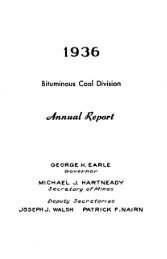- Page 2: ^>y^^^2^^^^The lAhtaryci^^:^'=^Y^^^
- Page 7 and 8: Official Document, No. 11.REPORTBUR
- Page 9 and 10: Official Document, No. 11.LETTER OF
- Page 11 and 12: Official Documiont, No. 11.CONTENTS
- Page 13 and 14: Official Document, No. 11.ANNUAL RE
- Page 15 and 16: No. 11. BUREAU OF MINES. ixhas been
- Page 17 and 18: No. 11. BUREAU OF MINES. xitli( iia
- Page 19 and 20: No. 11. BUREAU OF MINES. xiiirespon
- Page 21 and 22: No. 11. BUREAU OF MINES. xvparallel
- Page 23 and 24: No. 11. BUREAU OF MINES. xviithe lo
- Page 25 and 26: No. 11. BUREAU OF MINES. xixThese a
- Page 27: Coking Pnrrss
- Page 33 and 34: No. 11. BUREAU OF MINES. xxi.ishape
- Page 35 and 36: No. 11. BUREAU OF MINES. xxvthe fir
- Page 39 and 40: No. 11. BUREAU OF MINES. xxviithe C
- Page 41 and 42: No. 11. BUREAU OF MINES. xxixaid co
- Page 43 and 44: No. 11. BUREAU OF MINES. xxxiin all
- Page 47 and 48: No. 11. BUREAU OF MINES. xxxiiiat t
- Page 49 and 50: No. 11. BUREAU OF MINES. xxxvAnd al
- Page 51 and 52: No. 11. BUREAU OF MINES. xxxviiunde
- Page 53 and 54: iNo, 11. BUREAU OF MINES. XMcixol'
- Page 55 and 56: No. 11. BUREAU OF MINES. xliIbe sec
- Page 57 and 58: 'No. 11. BUREAU OF MINES. xliiii'ii
- Page 59 and 60: No. 11. BUREAU OF MINES. xlvsion th
- Page 61 and 62: No. 11. BUREAU OF MINES. xlviiILan
- Page 63 and 64: No. 11. BUREAU OF MINES. xlixtimes,
- Page 65 and 66: No. 11. BUREAU OP MINES. lithe defe
- Page 67 and 68: No. 11. BUREAU OF MINES. liiibe per
- Page 69 and 70: No. 11. BUREAU OF MINES. Ivpillars
- Page 71 and 72: No. 11. BUREAU OF MINES. Iviiwork o
- Page 73 and 74: Ko. 11. BUREAU OF MINES. liXluajori
- Page 75 and 76: Ko. 11. BUREAU OP MINES..l3tlprompt
- Page 77 and 78: No. 11. BUREAU OF MINES. IxiiiThe s
- Page 79 and 80:
No. 11.BUREAU OF MINES.ixvExpenses
- Page 81 and 82:
No. 11. BUREAU OF MINES. IxviiTAvel
- Page 83 and 84:
No. 11.BUREAU OF MINES.Fatal Accide
- Page 85 and 86:
No. 11. BUREAU OF MINES. Ixxi
- Page 87 and 88:
No. 11. BUREAU OF MINES. Ixxiiic
- Page 89 and 90:
No. 11. BUREAU OP MINES. IxxvCO cq
- Page 91 and 92:
No. 11. BUREAU OP MINES. Ixxvii. Ca
- Page 93 and 94:
No. 11. BUREAU OF MINES. IxxixT)
- Page 95 and 96:
No. 11. BUREAU OF MINES. Ixxxi
- Page 97 and 98:
No. 11. BUREAU OF MINES. Ixxxiiiow3
- Page 100 and 101:
PffOOUCT/ON/N GROSS TOAIieo.ooo.ooo
- Page 104 and 105:
D/y9G/?/PAf, ^HOW/NG THENUMBER OF P
- Page 107 and 108:
LAWS RELATINGTOCoal Mining( Ixxxv )
- Page 109 and 110:
Official Document, No. 11.LAWS RELA
- Page 111 and 112:
No. 11. MINING LAWS OF PENNSYLVANIA
- Page 113 and 114:
No. 11. MINING LAWS OF PENNSYLVANIA
- Page 115 and 116:
No. 11. MINING LAWS OF PENNSYLVANIA
- Page 117 and 118:
No. 11. MINING LAWS OF PENNSYLVANIA
- Page 119 and 120:
No. 11. MINING LAWS OF PENNSYLVANIA
- Page 121 and 122:
No. 11. MINING LAWS OF PENNSYLVANIA
- Page 123 and 124:
No. 11. MINING LAWS OF PENNSYLVANIA
- Page 125 and 126:
No. 11. MINING LAWS OF PENNSYLVANIA
- Page 127 and 128:
No. 11. MINING LAWS OF PENNSYLVANIA
- Page 129 and 130:
No. 11. MINING LAWS OF PENNSYLVANIA
- Page 131 and 132:
No. 11. MINING LAWS OP PENNSYLVANIA
- Page 133 and 134:
No. 11. MINING LAWS OF PENNSYLVANIA
- Page 135 and 136:
No. 11. MINING LAWS OF PENNSYLVANIA
- Page 137 and 138:
No. 11. MINING LAWS OF PENNSYLVANIA
- Page 139 and 140:
No. 11. MINING LAWS OF PENNSYLVANIA
- Page 141 and 142:
No. 11. MINING LAWS OF PENNSYLVANIA
- Page 143 and 144:
No. 11. MINING LAWS OF PENNSYLVANIA
- Page 145 and 146:
No. 11. MINING LAWS OP PENNSYLVANIA
- Page 147 and 148:
No. 11. MINING LAWS OF PENNSYLVANIA
- Page 149 and 150:
No. 11. MINING LAWS OF PENNSYLVANIA
- Page 151 and 152:
No. 11. MINING LAWS OP PENNSYLVANIA
- Page 153 and 154:
No. 11. MINING LAWS OF PENNSYLVANIA
- Page 155 and 156:
No. 11. MINING LAWS OP PENNSYLVANIA
- Page 157 and 158:
No. 11. MINING LAWS OF PENNSYLVANIA
- Page 159 and 160:
Ko. 11. MINING LAWS OF PENNSYLVANIA
- Page 161 and 162:
No. 11. MINING LAWS OF PENNSYLVANIA
- Page 163 and 164:
No. 11. MINING LAWS OF PENNSYLVANIA
- Page 165 and 166:
No. 11. MINING LAWS OF PENNSYLVANIA
- Page 167 and 168:
No. 11, MINING LAWS OF PENNSYLVANIA
- Page 169 and 170:
No. 11. MINING LAWS OF PENNSYLVANIA
- Page 171 and 172:
No. 11. MINING LAWS OF PENNSYLVANIA
- Page 173 and 174:
No. 11. MINING LAWS OF PENNSYLVANIA
- Page 175 and 176:
No. 11. MINING LAWS OF PENNSYLVANIA
- Page 177 and 178:
No. 11. MINING LAWS OF PENNSYLVANIA
- Page 179 and 180:
No. 11. MINING LA ATS JF PENNSYLVAN
- Page 181 and 182:
No. 11. MINING LAWS OF PENNSYLVANIA
- Page 183 and 184:
No. 11. MINING LAWS OF PENNSYLVANIA
- Page 185 and 186:
No. 11. MINING LAWS OF PENNSYLVANIA
- Page 187 and 188:
No. 11. MINING LAWS OF PENNSYLVANIA
- Page 189 and 190:
No. 11. MINING LAWS OF PENNSYLVANIA
- Page 191 and 192:
No. 11. MINING LAWS OP PENNSYLVANIA
- Page 193 and 194:
inHRACITE Mil DISTRICTS.12( clxxi )
- Page 195 and 196:
Official Document, No. 11.First Ant
- Page 197 and 198:
No. 11. FIRST ANTHRACITE DISTRICT.
- Page 199 and 200:
No. 11.FIRST ANTHRACITE DISTRICT.TA
- Page 201 and 202:
No. 11.FIRST ANTHRACITE DISTRICT.oo
- Page 203 and 204:
No. 11.FIRST ANTHRACITE DISTRICT.>>
- Page 205 and 206:
No, 11. FIRST ANTHRACITE DISTRICT 1
- Page 207 and 208:
s-INo. 11. P'lRST ANTHRACITE DISTRI
- Page 209 and 210:
"* CM
- Page 211 and 212:
No. 11. FIRST ANTHRACITE DISTRICT.
- Page 213 and 214:
o'^'nII' t,'S,No. 11. FIRST ANTHRAC
- Page 215 and 216:
No. 11. FIRST ANTHRACITE DISTRICT.
- Page 217 and 218:
No. 11.FIRST ANTHRACITE DISTRICT.a
- Page 219 and 220:
, cSNo. 11. FIRST ANTHRACITE DISTRI
- Page 221 and 222:
''-CIrockNo. 11. FIRST ANTHRACITE D
- Page 223 and 224:
!>No. 11. FIRST ANTHRACITE DISTRICT
- Page 225 and 226:
No. 11. FIRST ANTHRACITE DISTRICT.
- Page 227 and 228:
Official Document, No. 11.Second An
- Page 229 and 230:
No. 11. SECOND ANTHRACITE DISTRICT.
- Page 231 and 232:
No. 11. SECOND ANTHRACITE DISTRICT.
- Page 233 and 234:
: :No. 11. SECOND ANTHRACITE DISTRI
- Page 235 and 236:
No. 11. SECOND ANTHRACITE DISTRICT.
- Page 237 and 238:
No. 11. SECOND ANTHRACITE DISTRICT.
- Page 239 and 240:
;No. 11. SECOND ANTHRACITE DISTRICT
- Page 241 and 242:
Ifj 0) t. (No. 11. SECOND ANTHRACIT
- Page 243 and 244:
No. 11. SECOND ANTHRACITE DISTRICT.
- Page 245 and 246:
'No. 11. SECOND ANTHRACITE DISTRICT
- Page 247 and 248:
No. 11. SECOND ANTHRACITE DISTRICT.
- Page 249 and 250:
:No. 11. SECOND ANTHRACITE DISTRICT
- Page 251 and 252:
'I mIe;No. 11. SECOND ANTHRACITE DI
- Page 253 and 254:
o'.2No. 11. SECOND ANTHRACITE DISTR
- Page 255 and 256:
' c.'No. 11. SECOND ANTHRACITE DIST
- Page 257 and 258:
.c'ciiNo. 11. Second anthracite dis
- Page 259 and 260:
•*d, „,S^No. 11. SECOND ANTHRAC
- Page 261 and 262:
Official Document, No. 11.THIRD ANT
- Page 263 and 264:
No. 11. THIRD ANTHRACITE DISTRICT.
- Page 265 and 266:
j'•_K)1 ; 1No. 11.THIRD ANTHRACIT
- Page 267 and 268:
No. 11. THIRD ANTHRACITE DISTRICT.
- Page 269 and 270:
No. 11. THIRD ANTHRACITE DISTRICT.
- Page 271 and 272:
No. 11. THIRD ANTHRACITE DISTRICT.
- Page 273 and 274:
JNo. 11.THIKD ANTilRACJTE J)ISTI{J-
- Page 275 and 276:
Ko. 11. THIRD ANTHRACITE DISTRICT.
- Page 277 and 278:
No. 11. THIRD ANTHRACITE DISTRICT.
- Page 279 and 280:
lftt-05No. 11. THIRD ANTHRACITE DIS
- Page 281 and 282:
No. U. THIRD ANTHRACITE DISTRICT. 8
- Page 283 and 284:
. JNo. 11. THIRD ANTHRACITE DISTRIC
- Page 285 and 286:
:^31 CD, - , - =>;(: cd ,3£-- OK"
- Page 287 and 288:
w'No. 11. THIRD ANTHRACITE DISTRICT
- Page 289 and 290:
' ~;1No. 11. THIRD ANTHRACITE DISTR
- Page 291 and 292:
No. 11. THIRD ANTHRACITE DISTRICT.
- Page 293 and 294:
Official Document, No. 11,Fourth An
- Page 295 and 296:
'No. 11. FOURTH ANTHRACITE DISTRICT
- Page 297:
-5^0^Narrr:B upc/asrEXTTfTr or F/ff
- Page 300 and 301:
104 REPORT OF THE BUREAU OF MINES.
- Page 302 and 303:
106 REPORT OF THE BUREAU OF MINES.
- Page 304 and 305:
108 REPORT OF THE BUREAU OF MINES.
- Page 306 and 307:
110 REPORT OF THE BUREAU OF MINES.
- Page 308 and 309:
112 REPORT OF THE BUREAU OF MINES.
- Page 310 and 311:
114 REPORT OF THE BUREAU OF MINES.
- Page 312 and 313:
116 REPORT OF THE BUREAU OF MINES.
- Page 314 and 315:
118 REPORT OF THE RTTREAU OF MINES.
- Page 316 and 317:
J120 REPORT OF THE BUREAU OF MINES.
- Page 318 and 319:
122 REPORT OF THE BUREAU OF MINES.
- Page 320 and 321:
124 REPORT OF THE BUREAU OF MINES.
- Page 322 and 323:
126 illilPORT OF THE BUREAU OF MINE
- Page 324 and 325:
-^^r(128)
- Page 326 and 327:
130 REPORT OP THE BUREAU OF MINES O
- Page 328 and 329:
132 REPORT OF THE BUREAU OF MINES.
- Page 330 and 331:
134 REPORT OF THE BUREAU OF MINES.
- Page 332 and 333:
136 REPORT OF THE BUREAU OF MINES.
- Page 334 and 335:
138 REPORT OP THE BUREAU OF MINES.
- Page 336:
i40 REPORT OF THE BUREAU OF MINES.
- Page 340 and 341:
142 RKPOliT OF THE i3UilEAU OFMINES
- Page 342 and 343:
144 REPORT OF THE BUREAU OF MINES.
- Page 344 and 345:
146 REPORT OF THE BUREAU OF MINES.
- Page 346 and 347:
148 REPORT OP THE BUREAU OF MINES.
- Page 348 and 349:
150 REPORT OF THE BUREAU OF MINES.
- Page 350 and 351:
152 REPORT OF THE BUREAU OP MINES.
- Page 352 and 353:
154 REPORT OF THE BUREAU OF MINES.
- Page 354 and 355:
i156 REPORT OF THE BUREAU OP MINES.
- Page 356 and 357:
158 REPORT OF THE BUREAU OF MINES,
- Page 358 and 359:
160 R53PORT OF THE BUREAU OF MINES.
- Page 360 and 361:
162 REPORT OF THE INSPECTORS OF MIN
- Page 362 and 363:
164 REPORT OF THE INSPECTORS OF MIN
- Page 364 and 365:
166 REPORT OF THE BUREAU OF MINES.
- Page 366 and 367:
168 REPORT OF THE BUREAU OF MINES.
- Page 368 and 369:
170 REPORT OF THE BUREAU OF MINES.
- Page 370 and 371:
172 REPORT OF THE BUREAU OF MINES.
- Page 372 and 373:
174 REPORT OF THE BUREAU OF MINES.O
- Page 374 and 375:
176 REPORT OF THE BUREAU OF MINES.
- Page 376 and 377:
178 REPORT OF THE BUREAU OF MINES.
- Page 378 and 379:
iSO REPORT OF THE BUREAU OF MINES.
- Page 380 and 381:
182 REPORT OP THE BUREAU OF MINES.
- Page 382 and 383:
184 REPORT OF THE BUREAU OF MINES.
- Page 384 and 385:
186 REPORT OF THE BUREAU OF MINES.O
- Page 386 and 387:
188 REPORT OP THE BUREAU OF MINES.
- Page 388 and 389:
190 REPORT OF THE BUREAU OF MINES.
- Page 390 and 391:
192 REPORT OF THE BUREAU OF MINES.
- Page 392 and 393:
194 REPORT OF THE BUREAU OF MINES.
- Page 394 and 395:
196 REPORT OF THE BUREAU OF MINES.
- Page 396 and 397:
i9198 REPORT OF THE BUREAU OF MINES
- Page 398 and 399:
200 REPORT OF THE BUREAU OF MINES.
- Page 400 and 401:
202 REPORT OP THE BUREAU OP MINES.
- Page 402 and 403:
.; o t"" " c o CD I204 REPORT OF TH
- Page 404 and 405:
206 REPORT OF THE BUREAU OF MINES.
- Page 406 and 407:
347.208 REPORT OF THE BUREAU OF MIN
- Page 408 and 409:
'';210 RKPORT OF THE BUREAU OF MINE
- Page 410 and 411:
212 REPORT OF THE BtfRfiAtf OF MINE
- Page 412 and 413:
214 REPORT OF THE BUREAU OF MINES.
- Page 414 and 415:
216 REPORT OF THE BUREAU OF MINES.
- Page 416 and 417:
O218 REPORT OF THE BUREAU OF MINES.
- Page 418 and 419:
'c.••I ,^^220 REPORT OF THE BUR
- Page 420 and 421:
222 REPORT OF THE BUREAU OF MINES.
- Page 422 and 423:
0)224 REPORT OF THE BUREAU OP MINES
- Page 424 and 425:
^jJ ^ k^^^^^^^1 m 1'^( 226 )
- Page 426 and 427:
228 REPORT OF THE BUREAU OF MINES.
- Page 428 and 429:
230 REPORT OF THE BUREAU OF MINES.
- Page 430 and 431:
232 REPORT OF THE BUREAU OF MINES.
- Page 432 and 433:
234 REPORT OF THE BUREAU OP MINES.
- Page 434 and 435:
236 REI'ORT OF THE BUREAU OF MINES.
- Page 436 and 437:
238 REPORT OP THE BUREAU OF MINES.
- Page 438 and 439:
240 REPORT OF THE Bl'REAU OF MINES.
- Page 440 and 441:
242 REPOllT OF THE BUREAU OF MINES.
- Page 442 and 443:
244 REPORT OF THE BUREAU OF MINES.
- Page 444 and 445:
246 REPORT OF THE BUREAIT OF MINES.
- Page 446 and 447:
248 REPORT OF THE BUREAU OF MINES.
- Page 448 and 449:
.250 REPORT OP THE BUREAU OF MINES.
- Page 450 and 451:
252 REPORT OF THE BT'REAU OF MINES.
- Page 452 and 453:
'o«254 REPORT OF THE BUREAU OF MIN
- Page 454 and 455:
'256 REPORT OF THE BTTREAU OF MINES
- Page 456 and 457:
258 flEPORT OF THE BUREAU OF MINES.
- Page 458 and 459:
260 PwEPORT OF THE BUREAU OF MINES.
- Page 460 and 461:
262 REPORT OF THE BUREAU OF MINES.
- Page 462 and 463:
264 REPORT OF THE BUREAU OF MINES.
- Page 464 and 465:
! £'266 REPORT OF THE BUREAU OF MI
- Page 466 and 467:
(G)'l-jIEItia'i-6)( 268 )
- Page 468 and 469:
(270)
- Page 470 and 471:
272 REPORT OF THE BUREAU OF MINES.
- Page 472 and 473:
274 REPORT OF THE BUREAU OF MINES.
- Page 474 and 475:
276 REPORT OF THE BUREAU OP MINES.
- Page 476 and 477:
2?8 REPORT OF THE BUREAU OF MINES O
- Page 478 and 479:
280 REPORT OF THE BUREAU OF MINES.
- Page 480 and 481:
282 REPORT OF THE BUREAU OF MINES.
- Page 482 and 483:
284 REPORT OF THE BTJREAU OF MINES.
- Page 484 and 485:
286 REPORT OF THE BUREAU OP MINES.
- Page 486 and 487:
288 REPORT OP THE BUREAU OF MINES.
- Page 488 and 489:
. . .°°. . .oininicid;2, M'-^: a
- Page 490 and 491:
292 REPOFIT OF THK BURKAU OF MINES.
- Page 492 and 493:
1294 REPORT OF THE BUREAU OF MINES.
- Page 494 and 495:
296 REPORT OF THE BUREAU OF MINES.
- Page 496 and 497:
298 REPORT OF THE BUREAU OF MINES.
- Page 498 and 499:
'I^--o'300 REPORT OF THE BUREAU OF
- Page 500 and 501:
302 REPORT OF THE BUREAU OF MINES.
- Page 502 and 503:
C 304 >
- Page 504 and 505:
306 REPORT OF THE BUREAU OF JMINES.
- Page 506 and 507:
ia^ REPORT OF THE BUREAU OF MINES.
- Page 508 and 509:
''§10 ilEPORT OF THE BUREAU OF MIN
- Page 510 and 511:
312 REPORT OF THE BUREAU OF MINES.
- Page 512 and 513:
314 REPORT OP THE BUREAU OF MINEri.
- Page 514 and 515:
§16 REPORT OF THE BrfREAU Of MINER
- Page 516 and 517:
318 REPORT OF THE P.TTREAIT OF MINE
- Page 518 and 519:
320 REPORT OF THE BUREAU OF MINES.
- Page 520 and 521:
322 REPORT OF THE BUREAU OF MINES.
- Page 522 and 523:
324 REPORT OF THE BUREAU OF MINES.
- Page 524 and 525:
326 REPORT OF THE BUREAU OF MINES.
- Page 526 and 527:
328 REPORT OF THE BUREAU OF MINES.
- Page 528 and 529:
I..(UDdJlId)£iS55"i:55-5ESfe;E;;.O
- Page 530 and 531:
N-cccccccc.bI332 REPORT OF THE BURE
- Page 532 and 533:
334 REPORT OF The bureau of mines.
- Page 534 and 535:
336 REPORT OF THE BUREAU OF MINES.
- Page 536 and 537:
;o^':^' • d338 REPORT OF THE BURE
- Page 538 and 539:
'346 REPORT OF THE BUREAU OF MINES.
- Page 540 and 541:
S42 REPORT OF THE BUREAU OF MINES.
- Page 542 and 543:
344 REPORT OF THE BUREAU OF MINES.
- Page 544 and 545:
346 REPORT OF THE BUREAU OF MINES.
- Page 546 and 547:
.348 REPORT OP THE BLfREAU OF MINES
- Page 548 and 549:
350 REPORT OF THE BUREAU OF MINES.
- Page 550 and 551:
352 REPORT OF THE BUREAU OF MINES.
- Page 552 and 553:
' OJ'''354 REPORT OF THE BUREAU OP
- Page 554 and 555:
356 REPORT OF THE BUREALT OF MINES.
- Page 556 and 557:
358 REPORT OF THE BUREAU OF MINES.
- Page 558 and 559:
.'360 REPORT OF THE BUREAU OP MINES
- Page 560 and 561:
362 REPORT OF THE BUREAU OF MINES.
- Page 562 and 563:
364 REPORT OF THE BUREAU OP MINES.
- Page 564 and 565:
IS( :m )
- Page 566 and 567:
368 REPORT OF THE BUREAU OF MINES.
- Page 568 and 569:
370 REPORT OF THE BUREAU OF MINES.
- Page 570 and 571:
272 REPORT OF THE BUREAU OF MINES.
- Page 572 and 573:
3?4 REPORT OF THE BUREAU OF MINES.
- Page 574 and 575:
376 REPORT OF THE BUREAU OF MINES.
- Page 576 and 577:
378 REPORT OF THE BUREAU OF MINES.
- Page 578 and 579:
I380 REPORT OF THE BUREAU OF MINES.
- Page 580 and 581:
: : :1.382 REPORT OF THE BUREAU OF
- Page 582 and 583:
^i^;^/i\\(384)
- Page 584 and 585:
—I386 REPORT OF THE BUREAU OF MIN
- Page 586 and 587:
^8« REPORT OF THE BUREAU OF MINES.
- Page 588 and 589:
390 REPORT OF THE BITREATT OF MINES
- Page 590 and 591:
392 REPORT OF THE BUREAU OF MINES.
- Page 592 and 593:
394 REPORT OF THE BUREAU OP MINES.
- Page 594 and 595:
396 REPORT OF THE BUREAU OF MINES.
- Page 596 and 597:
398 REPORT OF THE BUREAU OF MINES;
- Page 598 and 599:
. .400 REPORT OF THE BUREAU OF MINE
- Page 600 and 601:
402 REPORT OF THE BUREAU OF MINES.
- Page 602 and 603:
404 REPORT OF THE BUREAU OF MINES.
- Page 604 and 605:
406 REPORT OF THE BUREAU OP MINES.
- Page 606 and 607:
'JI408 REPORT OF THE BUREAU OF MINE
- Page 608 and 609:
410 REPORT OF THE BUREAU OF MINES.
- Page 610 and 611:
"412 REPORT OF THE BUREAU OF MINES.
- Page 612 and 613:
(414 )
- Page 614 and 615:
416 REPORT OF THE BUREAU OF MINES.
- Page 616 and 617:
418 REPORT OF THE BUREAU OF MINES.
- Page 618 and 619:
420 REPORT OF THE BUREAU OF MINES.
- Page 620 and 621:
422 REPORT OP THE BUREAU OF MINES.
- Page 622 and 623:
424 REPORT OP THE BUREAU OP MINES.
- Page 624 and 625:
426 REPORT OF THE BUREAU OF MINES.
- Page 626 and 627:
428 REPORT OF THE BUREAU OF MINES.
- Page 628 and 629:
430 REPORT OF THE BUREAU OF MINES.
- Page 630 and 631:
432 REPORT OF THE BUREAU OF MINES.
- Page 632 and 633:
In"^ oJ d rt cJ «J rt rt •= JlT4
- Page 634 and 635:
436 REPORT OP THE BUREAU OP MINES.
- Page 636 and 637:
. tE438 REPORT' OF f Hfi BUREAtf OF
- Page 638 and 639:
'o, oI in440 REPORT OF THE BUREAU O
- Page 640 and 641:
(44V!)
- Page 642 and 643:
:444 ftfiPORf OF The bureau of mine
- Page 644 and 645:
446 REPORT OF THE BUREAU OP MINES.
- Page 646 and 647:
-448 REPORT OF THE BUREAU OF MINES.
- Page 648 and 649:
450 REPORT OF THE BTTREAU OF MINES.
- Page 650 and 651:
452 REPORT OF THE BUREAU OF MINES.
- Page 652 and 653:
454 REPORT OF THE BUREAU OF MINES.
- Page 654 and 655:
1c)oxs:456 REPORT OF THE BUREAU OF
- Page 656 and 657:
458fjREPORT OF THE BUREAU OF MINES.
- Page 658 and 659:
460 REPORT OF THE BUREAU OF MINES.
- Page 660 and 661:
- °I462 REPORT OF THE BUREAU OF MI
- Page 662 and 663:
464 REPORT OF THE BUREAU OF MINES.
- Page 664 and 665:
C;466 REPORT OF THE BUREAU OF MINES
- Page 666 and 667:
m REPORT OF THE BtTREAtJ OF MINES.
- Page 668 and 669:
4?0 REPORT OF THK BUREAU OF MINES.
- Page 670 and 671:
472 REPORT OF THE BUREAU OF MINES.
- Page 672 and 673:
474 REPORT OF THE BUREAU OF MINES.
- Page 674 and 675:
476 REPORT OF THE BUREAU OP MINES.
- Page 676 and 677:
478 REPORT OP THE RUREAU OF MINES.
- Page 678 and 679:
480 REPORT OF THE BUREAU OF MINES.
- Page 680 and 681:
C-S482 RKPOPvT OF THE BUREAU OF MIN
- Page 682 and 683:
4S4 REPORT OF THE BUREAU OF MINES.
- Page 684 and 685:
486 REPORT OP THE BUREAU OF MINES.
- Page 686 and 687:
REPORT OF THE BUREAU OF MINES.Off.
- Page 688 and 689:
490 REPORT OF THE BUREAU OF MINES.
- Page 690 and 691:
492 REPORT OF THE BUREAU OF MINES.
- Page 692 and 693:
494 REPORT OF THE J3UREAU OF MINES.
- Page 694 and 695:
''I' o496 REPORT OF THE BUREAU OF M
- Page 696 and 697:
( 41)8 )
- Page 698 and 699:
500 RErORT OF THE BUREAU OF MINES.O
- Page 700 and 701:
502 REPORT OF THE BtJREAtT OF MINES
- Page 702 and 703:
504 REPORT OF THE BUREAU OF MINES.
- Page 704 and 705:
506 REPORT OF THE BUREAU OF MINES.
- Page 706 and 707:
508 REPORT OF THE BUREAtl OF MINES.
- Page 708 and 709:
510 REPORT OF THE BUREAU OF MINES.
- Page 710 and 711:
1 3:-W'^•O' o~512 REPORT OF THE B
- Page 712 and 713:
514 REPORT OF THE BUREAU OF MINES.
- Page 714 and 715:
516 REPORT OF THE BUREAU OF MINES.
- Page 716 and 717:
518 REPORT OF THE BUREAU OF MINES.
- Page 718 and 719:
oof.coal,small520 REPORT OP THE BUR
- Page 720 and 721:
522 REPORT OF THE BUREAU OF MINES.
- Page 722 and 723:
#':^^a*4\*'-^- .-r.(i^^) -:]"' Vh
- Page 724 and 725:
526 REPORT OF THE BUREAU OF MINES.
- Page 726 and 727:
iiui.5:28 REPORT OF THE BUREAU OF M
- Page 728 and 729:
530 REPORT OF THE BUREAU OF MINES.
- Page 730 and 731:
532 REPORT OF THE BUREAU OP MINES.
- Page 732 and 733:
S34 REPORT OF THE BUREAU OF MINES.
- Page 734 and 735:
536 REPORT OF THE BUREAU OF MINES.
- Page 736 and 737:
..^.I5^I ni•S. • o.'538 REPORT
- Page 738 and 739:
_^540 REPORT OF THE BUREAU OF MINES
- Page 740 and 741:
542 REPORT OF THE BUREAU OF MINES.
- Page 742 and 743:
544 REPORT OF THE BUREAU OF MINES.
- Page 744 and 745:
546 REPORT OF THE BUREAU OF MINES.
- Page 746 and 747:
^—'Ir; c548 REPORT OF THE BUREAU
- Page 748 and 749:
)ifl'^( r,r,(t
- Page 750 and 751:
552 INDEX. Off. Doc.Page.An act to
- Page 752 and 753:
S54 INDEX. Off. Doc.Page.Classifica
- Page 754 and 755:
556 INDEX. Off. Doc.FIRST BITUMINOU
- Page 756:
5"'8 INDEX. Off. Doc.EIGHTH BITUMIN




![1945 Anthracite Annual Report Districts 19 - 25 [Adobe pdf - 9148Kb]](https://img.yumpu.com/50308099/1/190x119/1945-anthracite-annual-report-districts-19-25-adobe-pdf-9148kb.jpg?quality=85)


![1937 Anthracite Annual Report Districts 1 - 11 [Adobe pdf - 9394Kb]](https://img.yumpu.com/43539962/1/190x119/1937-anthracite-annual-report-districts-1-11-adobe-pdf-9394kb.jpg?quality=85)






![1931 Anthracite Annual Report Districts 1 - 11 [Adobe pdf - 8007Kb]](https://img.yumpu.com/39427789/1/190x119/1931-anthracite-annual-report-districts-1-11-adobe-pdf-8007kb.jpg?quality=85)

